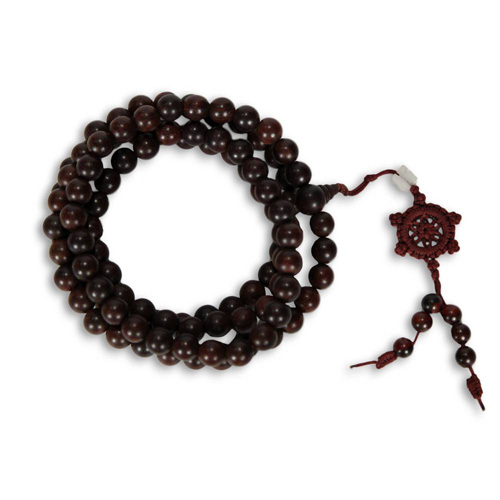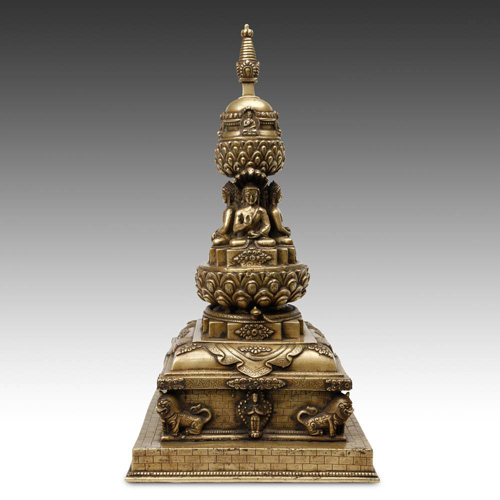Appreciating Buddhist Art: Part Four – Ritual Tools and Symbols
PRIMITIVE - Friday, August 18, 2017By Glen Joffe
It’s impossible to deal in world art on any scale and not have frequent encounters with world religion; primarily because there aren’t five religions in the world, but somewhere around 4,200! Each of those religions usually has its own rites and rituals, daily ceremonies, and celebratory special occasions; and in turn, implements and visual symbols associated with their realization. Those implements and symbols can range from everyday objects to esoteric masterworks. Sometimes they are mass produced; most often they are one-of-a-kind, their creation evidencing handwork, devotion, and rich artistic traditions.
The implements and symbols used in service to the world’s religions are not found solely in temples and edifices dedicated to worship, but in just about all places ranging from private homes to public spaces. Ceremonies, rites and rituals and the implements and symbols associated with them may vary from religion to religion. Even within any given religion or practice, the implements used and symbols accessed may be tempered by personal preference or style of worship. However, in just about every religion, specific implements and symbols are reserved for particular uses and ceremonies.
Religious implements and symbols may be harnessed for a wide variety of reasons: for example, to initiate, propitiate, bring rain, send souls to heaven, exorcise demons and evil spirits, soothe the mind and destroy the ego; and in the case of all symbols, to represent the concepts associated with the religious practice. The implements and symbols used to achieve specific objectives are loaded with symbolic meaning and may even be imbued with magical power and potency when properly activated. Even the purely symbolic can be real weapons of transformation capable of changing behavior and illuminating the mind.
Religious implements and symbols vary dramatically in terms of use, size and appearance from religion to religion. Although crossover does exist; generally speaking, any individual religion will have implements and symbols endemic to itself. It should be noted, all implements are symbols; but not all symbols are implements. Generally speaking, implements can be defined as three dimensional, functional objects. Buddhism is especially rich in the implements and symbols used in its practice. Here is a list and brief explanation of some of those implements and symbols:
 |
Seated Figure Of Quan Yin with Agni radiance; PRIMITIVE ID #A1400-261 | |
1) Agni: essentially a flame, Agni appears most often as a component in statuary, frequently as the madorla or radiance behind a deity. Agni is a cleansing tool and may be viewed as a protective tool as well.
 |
Mala or Ashkamala Meditation Beads; PRIMITIVE ID #J1309-216 |
|
2) Ashkamala: the Ashkamala is essentially a Buddhist rosary symbolizing the endless cycle of birth, death and rebirth. In Buddhist tradition, it is also a symbol of many deities, most notably Avolokitesvara, the deity of compassion.
3) Bumpa: a ritual vase representing the complete expanse of the universe, which may be interpreted as the endless expanse of the mind. Two kinds of Bumpa exist; the main vase and the daily vase. The main vase is usually placed in the center of a Mandala, while the daily vase resides on the Lama’s table for use during various rituals. The Bumpa or vase is also one of the Ashtamangala, or Eight Auspices of Good Fortune.
 |
Chaitya or Buddhist Stupa; PRIMITIVE ID #A0702-234 | |
4) Chaitya: the Chaitya is the Buddhist Stupa, which is a representation of the Buddhist universe. Sometimes square and sometimes round with steps or levels tapering upwards, each step or level represents a heaven, the topmost part being the point of enlightenment.
5) Chakra Wheel: the Chakra Wheel is also called the Dharmachakra. It symbolizes the wheel of the law, or Buddhist Dharma. It is also one of the Ashtamangala, or Eight Auspices of Good Fortune. It has eight spokes representing the eight fold path to salvation.
6) Chandra: Chandra is the moon and sometimes appears as a radiance behind or above a deity. It symbolizes the unity of opposites.
7) Chatra, Umbrella or Parasol: in Tibetan Buddhism, the Chatra is considered one of the Ashtamangala, or the Eight Auspices of Good Fortune. It can be viewed as a device capable of protecting one’s practice.
8) Dadar: the Dadar is an arrow appearing frequently as an attribute of the deity Saraha, although many deities may wield it. The arrow symbolically represents the piercing of the duality concept so it can be transformed into non-duality. It is also the symbol of awareness and in some Buddhist traditions it is also called the Bana.
 |
Damaru or Two-Headed Drum; PRIMITIVE ID #A0901-017 | |
9) Damaru: the Damaru is a smaller two-headed drum. In Tibetan Buddhism it is composed of two pieces of cranium. The symbolism and energetic properties of the Damaru are extensive. Essentially a musical instrument, it is used to mark time during important rituals as a means of regulation.
10) Dani: the Dani is an incense burner; essentially a metal pot used to burn incense when propitiating deities.
 |
Dhyangro Or Shaman's Drum; PRIMITIVE ID #A020102-174 | |
11) Dhyangro: the Dhyangro is another type of drum called a frame drum. It may be single or double-headed, struck with a mallet or contain beads, stones, or balls inside so that it will sound when turned. Many Dhyangro are equipped with a handle, which frequently is fashioned like a Phurba, or ritual dagger.
 |
Dipa or Butter Lamp; PRIMITIVE ID #A1105-187 | |
12) Dipa: the Dipa is essentially a butter lamp used in the propitiation of deities.
13) Dhvaja: the Dhvaja is a banner signifying the victory of Buddhism; specifically, the victory of Buddha over the impediments to enlightenment. It is also known as the Victory Banner and is one of the Ashtamangala, or Eight Auspices of Good Fortune.
 |
Large scale Ghanta or Temple Bell; PRIMITIVE ID #A0702-235 | |
14) Ghanta: the Ghanta is a ritual bell. Although the sound of the bell may be equated with the OM sound, it is the most commonly used musical instrument in all Buddhist ritual. When used in conjunction with the Dorje or Vajra in meditation it represents the sound of Buddha’s teachings and the attainment of wisdom. In tantric practice, it is said to drive away evil spirits. Its sound can also represent the union of male and female principles, or the creation of non-duality.
15) Kalasa: the Kalasa is vessel, basically a bowl that may be lidded or not. It symbolizes immortality, for it is said to hold the elixir of life.
 |
Kapala Or Ritual Skull Cup; PRIMITIVE ID #A0506-1112 | |
16) Kapala: the Kapala is also called the Skull Cup. Typically fashioned from a human skull it can also be formed from precious metal and encrusted with jewels and gemstones. It is said to hold blood and symbolizes the dissolution of the physical universe. It is also a symbol of the potency of various deities and specific practices.
17) Kartika: the Kartika is a small crescent shaped knife symbolizing the severance of worldly bonds.
18) Khadga: a sword. The Khadga is a symbol of enlightenment. It is wielded to destroy ignorance and sever the bonds of worldly attachment. Frequently, it has flames or Agni radiating from the end, which further illuminate and ultimately destroy ignorance.
 |
Khatavanga; PRIMITIVE ID #A1406-175 | |
19) Khartawanga: the Khartawanga is also known as a Khatavanga. It is a form of a club, which can be made of bone, wood, or metal. It symbolizes the smashing of impediments to enlightenment.
20) Khata: the Khata is a ceremonial scarf frequently used in Tibetan Buddhism. It symbolizes purity and compassion and is worn or given at numerous ceremonies and on multiple occasions.
 |
Mandala of creativity as seen at PRIMITIVE |
|
21) Mandala: the word Mandala literally means circle in Sanskrit. A visual aid that can be thought of as architecture with four cardinal points relating to the four directions serving as entrances and exits, it serves as a point of concentration in meditation. The Mandala is the graphic representation of the process leading to the attainment of insights. Those insights can also culminate in the activation of supernatural forces.
22) Matsya: the Matsya are a pair of fish. One of the Ashtamangala, or Eight Auspices of Good Fortune, they symbolize beings rescued from the ocean of earthly misery called Samsara in Buddhism.
23) Naga: the Naga are serpents and when propitiated can bring rain. They are also considered the protectors of the Dharma, or laws of Buddhism.
24) Padma: the Padma is a lotus flower representing purity and self-realization. It is also one of the Ashtamangala or Eight Auspices of Good Fortune.
 |
Standing Phurba; PRIMITIVE ID #A1001-641 | |
25) Phurba: also known as a Kila, ritual dagger or magic dart, the Phurba is used to pin heaven and earth to slay or dissolve ignorance, hatred, aggression, intolerance, insensitivity, etc.
 |
Large scale manual Prayer Wheel; PRIMITIVE ID #A0901-055 | |
26) Prayer Wheel: the Prayer Wheel is a Buddhist instrument composed of a cylinder atop a handle with a weighted extension or turner. The cylinder may be filled with mantras or repeatable prayers. Each turn of the wheel represents a recitation of the prayers inside. Prayer Wheels are not necessarily hand held and may be turned manually without the aid of a turner. They may also be large or small, free standing or embedded in walls.
 |
Sankha Or Conch Shell Trumpet; PRIMITIVE ID #A1702-004 | |
27) Sankha: the Sankha is a conch shell. Used as a trumpet it represents the penetrating sound of the Dharma calling practitioners from the deep slumber of ignorance so they will work for their own benefit and the benefit of others. The conch is considered the original horn trumpet and is also one of the Ashtamangala, or Eight Auspices of Good Fortune.
28) Shrivasta or Endless Knot: the Shrivasta is also called the Endless Knot or Love knot. It is a symbol of the ultimate unity of all things as well as the intertwining of love, wisdom and compassion. It is one of the Ashtamangala, or Eight Auspices of Good Fortune.
29) Swastika: in Buddhism the Swastika symbolizes the eternal aspects of the Dharma.
 |
Single Tingsha with horn knocker; PRIMITIVE ID #A1108-033 | |
30) Tingsha: the Tingsha are small cymbals usually presented in pairs although they may also be presented singly with a knocker attached. When struck together or hit by the knocker a harmonious long tone is produced, the sound itself said to be an offering of harmony.
31) Utpala: the Utpala is a half-closed lotus representing the unfolding of self-realization.
 |
Vajra; PRIMITIVE ID #A1105-215 | |
32) Vajra: the Vajra is a club like form with two ribbed spherical heads meeting at a ball shaped center. In Tibetan it is called a Dorje. Vajra is Sanskrit for thunderbolt; and it is also known as the indestructible diamond. Whatever it is called, it is meant to destroy all types of ignorance. It can also appear as two Vajras crossed and is then known as a Double Vajra or Double Dorje. Used in conjunction with the Ghanta it represents the path to enlightenment.